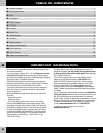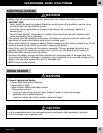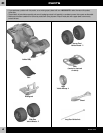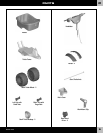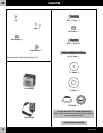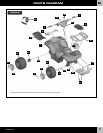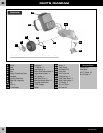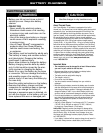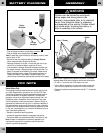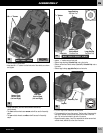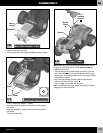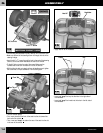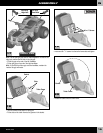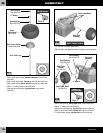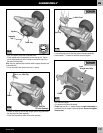
10
B9785b-0920
BATTERY CHARGING
GE
Battery
Connector
Charger
Connector
A
B
• Plug the charger connector into the battery connector
A
.
• Plug the charger into a standard wall outlet
B
.
Note: If power flow to the wall outlet is controlled by a switch, make
sure the switch is “ON”.
• Before first-time use, charge the battery for at least 18 hours.
Never charge the battery longer than 30 hours.
• Recharge the battery for at least 14 hours after each use of your
vehicle. Do not charge the battery longer than 30 hours.
• Once the battery is charged, disconnect the battery connector from
the charger connector. Unplug the charger from the wall outlet. The
battery is now ready to be installed in your vehicle. Please see the
Battery Installation section on page 20 for detailed instructions on
installing your battery. If your battery is already installed in your
vehicle, simply re-connect the motor harness connector to the battery.
WARNING
Children can be harmed by small parts,
sharp edges and sharp points in the
vehicle's unassembled state, or by electrical
items. Care should be taken in unpacking
and assembly of the vehicle. Children should
not handle parts, including the battery, or
help in assembly of the vehicle.
ASSEMBLY
1
Vehicle
Rack
Hint: The rack is located on the front end of the vehicle. If it has been
removed, please fit the rack to the pegs on the front end of the vehicle.
• Fit a #8 x
3
/4" screw into one of the indents in the rack.
• Using a Phillips screwdriver, turn the screw to make a hole in the
rack. Continue to tighten the screw with the Phillips screwdriver.
• Repeat this procedure to assemble three more #8 x
3
/4" screws into
the rack.
#8 x
3
/4" Screws
United States Only
This equipment has been tested and found to comply with the limits
for a Class B digital device, pursuant to Part 15 of the FCC Rules.
These limits are designed to provide reasonable protection against
harmful interference in a residential installation. This equipment
generates, uses and can radiate radio frequency energy and, if not
installed and used in accordance with the instructions, may cause
harmful interference to radio communications. However, there is no
guarantee that interference will not occur in a particular installation. If
this equipment does cause harmful interference to radio or television
reception, which can be determined by turning the equipment off and
on, the user is encouraged to try to correct the interference by one or
more of the following measures:
• Reorient or relocate the receiving antenna.
• Increase the separation between the equipment and receiver.
• Consult the dealer or an experienced radio/TV technician for help.
Note: Changes or modifications not expressly approved by the
manufacturer responsible for compliance could void the user’s
authority to operate the equipment.
FCC NOTE
F



